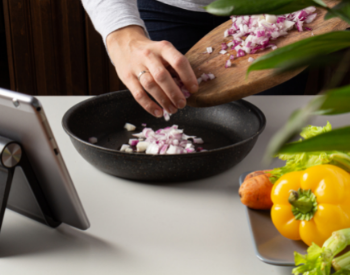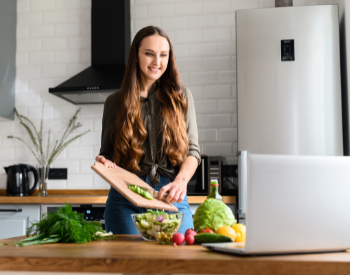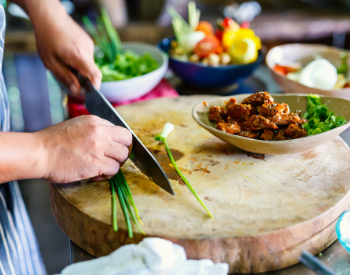Take advantage of virtual spaces by bringing your cooking skills online. The recent transition from taking in-person events to online platforms has made it more accessible for people to connect with your business. As the restaurant industry continues to adjust to limited dining capacities, a decrease in dine-in customers, and other changes, many establishments are looking for new streams of revenue.
Hosting virtual cooking classes, bartending courses, or sharing recipes online are ways restaurants have been connecting with their customers virtually. Many people are looking to fill their free time with learning new skills like cooking. The idea of learning how to make restaurant-style meals at home is appealing to eager customers. By offering a virtual cooking class hosted by chefs at your restaurant, you’ll be able to attract customers to your business in a new way.
If hosting cooking or bartending classes online is something your restaurant is interested in doing, consider turning your kitchen into a filming studio that is equipped for creating all kinds of virtual content.
Why Should You Turn Your Kitchen Into A Filming Studio?

Exploring the world of virtual spaces allows hosts and guests to interact with each other in a non-traditional, but effective manner. A cooking class is a perfect opportunity to connect with customers, drive traffic to your business, and increase revenue. You already have a professional kitchen with all the tools needed to create restaurant-quality meals at your hands, but setting the stage for your virtual cooking courses is just as important.
To ensure that your online cooking class runs smoothly, finding the right camera and sound equipment, lighting, and backdrop is essential. By putting together a filming studio space for virtual classes, you’ll increase the quality of your videos which makes it easier for customers to follow along. Accessibility is key in virtual spaces, so finding ways to improve the setting and overall experience of an online cooking class leaves attendees feeling satisfied and instantly attracts more guests.
How To Turn Your Kitchen Into A Filming Studio
There are many moving parts to creating an ideal filming space for your virtual cooking classes. However, it’s all much easier than it seems to be. Even if you aren’t the most tech-savvy individual, you can still put together a filming studio that produces high-quality content. You might even be surprised to learn you already have most of the equipment needed to get started. Below is a step-by-step guide on how to turn your traditional restaurant kitchen into a studio space.
1. Choose The Right Equipment
The overall quality of your video relies heavily on the lighting, camera, and sound equipment used to film. However, you don’t have to invest in overly expensive camera equipment to get started. By purchasing a few simple items, you’ll be able to put together a small studio in your kitchen.
Filming Equipment To Consider Purchasing:
- Laptop
- Camera or laptop camera
- Additional camera with a zoom lens
- Tripod or laptop stand
- Camera microphone or computer microphone
- Softboxes for additional lighting
Don’t be afraid to start small. If you’re looking to stay within your budget, you don’t have to buy all the filming equipment at once. The lighting found in your restaurant kitchen or chosen location should provide enough visibility for your audience. A laptop with a functioning camera and microphone will be enough for you to get started. Using a tripod or a laptop stand will provide stability when filming and allow for viewers to easily follow your instructions. As your virtual cooking classes take off, you can start investing in better quality equipment to upgrade your filming studio for your audience.
2. Choose The Right Location

Your restaurant’s kitchen wasn’t necessarily designed with the capacity to be turned into a filming studio. Nonetheless, you’ll still be able to find a space in your kitchen that is perfect for filming. Your restaurant’s priority will always be preparing orders and serving customers, so make sure to pick a time and day for filming where your kitchen will be empty for at least a couple of hours. Many chefs who host virtual cooking classes usually film in between lunch and dinner rushes, after hours, or on weekends, depending on their current schedule.
When choosing the right location in your kitchen to set up your filming studio, there are a couple of things to keep in mind. You’ll want to choose an area in your kitchen where equipment is easily accessible and within reach. Demonstrating how a recipe is made requires enough space for viewers to see what you are doing. Consider filming in front of a flat surface such as a table, moveable island, or prep station. It would be helpful to film in a location that isn’t near any entrances or exits so you can minimize any disruptions.
3. Create A Filming Team
Although your virtual cooking classes could be run by just one person in theory, it’s much easier if you have a small team working together to ensure filming runs smoothly. Having a team member behind the camera to help control the technology and make any adjustments while filming is ideal. That way, whoever is demonstrating a recipe can simply focus on their instructions and the dynamics of the class.
You can also use a team member to moderate the flow of the class. Since you'll be preparing ingredients, talking through instructions, and cooking meals, you won’t be able to pay attention to comments viewers are making or notice any details that could be improved during your class.
Another team member can take notice of the chat during your cooking class as well as make any suggestions on how the flow or structure of your video could be improved. Talk to some of your staff to see if they would be interested in helping you film videos or consider putting out a job advertisement for the specific role of helping you film cooking classes.
4. Set The Scene

Before filming, take some time to properly create a backdrop that is aesthetically pleasing for your audience and functional for your needs. A clean, simple background with an emphasis on you and whatever ingredients or equipment you’re working with would work best. Set up your camera and test several angles in advance until you find one that fits.
Remember that whoever is demonstrating the recipe should be in the center of the frame. If you are using an additional camera to film detail-oriented shots, be sure to place the camera in an area that is close to the surface you are working on. Test the camera angles and adjust the settings on your camera to make sure objects appear in focus.
Feel free to decorate the background of your shot as well. Adding your restaurant’s logo, fun pops of color, plants, or kitchen-themed decorations will bring a unique touch to your filming studio. The audience will appreciate a good-looking backdrop to your cooking classes, and it will help set the tone of your video. Less is more, so be sure not to overwhelm the background of your shot with too many decorations as it can be distracting for your viewers in the long run.
5. Do A Test Run
Taking some time to do a test run before going live online can save you many mistakes in the long run. Before logging into your virtual space and interacting with your viewers, it’s a good idea to practice your entire class before you present it to others. By running through each part of the class with your team members, you’ll be able to notice what works and what could be improved.
Performing a test run allows you and your team to gauge the pace of the class, and adjust as needed to meet certain time limits or shorten the amount of time spent filming. If you’ve never been in front of the camera before, performing a run-through of your class will help you get used to speaking to an audience and directing a video. You’ll also be able to catch any unexpected technical difficulties. A test run never hurts, and it’s better to avoid making mistakes live on camera.









